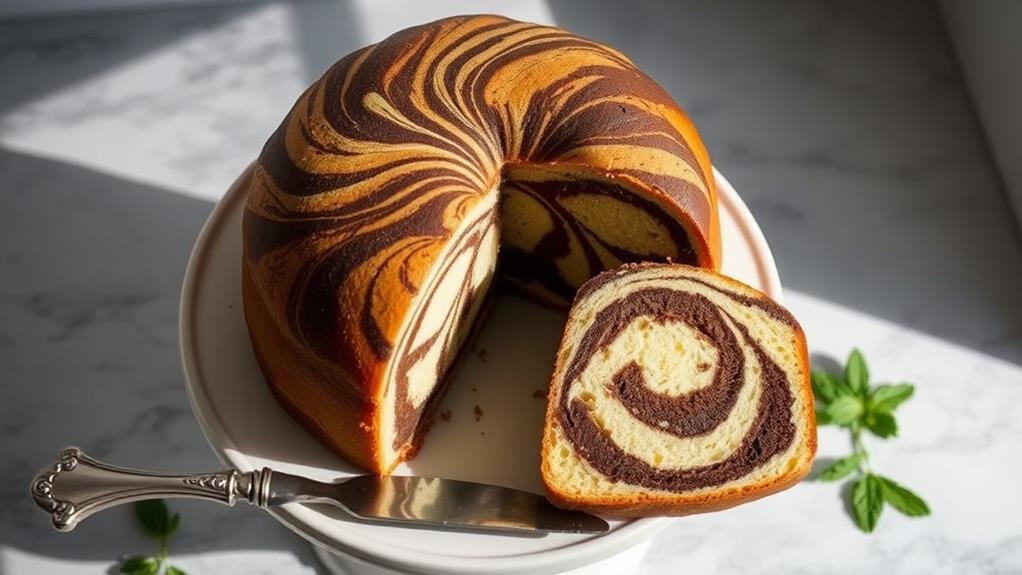Now, to make this beautiful Marble Pound Cake, you'll want to keep things simple but precise – just like my mother always taught me. Start by making sure your ingredients aren't straight from the fridge; let them sit until they're about room temperature, roughly 70-72°F if you're fussy about such things (I just touch them with the back of my hand).
Split your cake batter into two bowls – put three-quarters in one bowl for the vanilla part, and a quarter in the other for the chocolate. That's the secret to getting it just right. Been doing it this way for forty years, never failed me yet.
When it comes to the marbling – and this is where folks often go wrong – don't get carried away with the swirling. Take a knife and run it through the batter in a figure-eight pattern exactly three times. Any more and you'll end up with mud, any less and you won't get those lovely streaks we're after.
Trust me on this – I've made every mistake in the book so you don't have to. Keep your movements gentle but purposeful, like you're folding egg whites into a souffle. Before you know it, you'll have a cake that's worthy of any church social or family gathering.
Recipe

A marble pound cake combines the rich, buttery goodness of traditional pound cake with beautiful swirls of chocolate throughout. This classic dessert gets its name from the mesmerizing pattern created when vanilla and chocolate batters are gently swirled together, creating a marbled effect that's as visually striking as it's delicious.
The key to achieving the perfect marble pound cake lies in creating two distinct batters – one vanilla and one chocolate – with just the right consistency. When properly executed, the end result is a moist, tender crumb with a delicate balance of flavors that has delighted dessert lovers for generations.
- 3 cups all-purpose flour
- 1 teaspoon baking powder
- 1/2 teaspoon salt
- 1 cup unsalted butter, softened
- 2 cups granulated sugar
- 4 large eggs
- 1 teaspoon vanilla extract
- 1 cup whole milk
- 1/4 cup unsweetened cocoa powder
- 2 tablespoons hot water
Preheat oven to 325°F (165°C) and grease a 10-inch tube pan. Sift flour, baking powder, and salt together. In a large bowl, cream butter and sugar until light and fluffy. Beat in eggs one at a time, then add vanilla. Gradually add flour mixture alternating with milk. Divide batter in half. Mix cocoa powder and hot water, then blend into one portion of batter. Layer vanilla and chocolate batters alternately in the pan, then swirl with a knife. Bake for 60-70 minutes until a toothpick comes out clean.
For best results, make sure all ingredients are at room temperature before beginning. The marbling effect should be achieved with just a few swirls – over-mixing will blur the distinct patterns.
Cool the cake in the pan for 15 minutes before removing, and always use the correct pan size as specified to prevent overflow or uneven baking.
This classic marble pound cake combines the timeless appeal of vanilla and chocolate in a beautifully swirled pattern. Dating back to the 1960s when home bakers began experimenting with ways to make desserts more visually striking, marble cake quickly became a staple at family gatherings and celebrations.
The rich, buttery crumb stays moist for days, while the striking light and dark swirls create an impressive presentation that belies the recipe's straightforward preparation. Though pound cakes originated in Europe where bakers used a pound each of flour, butter, eggs and sugar, this modern version maintains the dense, velvety texture while incorporating the dramatic marbling effect that makes it a standout on any dessert table.
Conclusion
Take equal parts vanilla and chocolate cake batter – trust me, measuring them out the same makes all the difference. I've been baking these cakes for 40 years, and getting that balance right is crucial.
Pour the vanilla batter first, then add your chocolate in good-sized dollops. Now here's the important bit: take a butter knife or spatula and give it just 3 or 4 gentle swirls through the mixture. Don't get carried away – I used to make that mistake, and you end up with a muddy-looking cake instead of those nice, clean swirls.
Think of it as making waves in the batter. Too much mixing and you'll lose those pretty patterns that make everyone say "How did you do that?" when you slice it. Been there, done that, learned the hard way. Just those few swirls will give you that classic marbled look every time.

